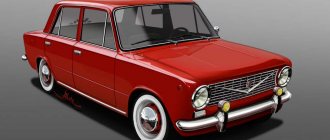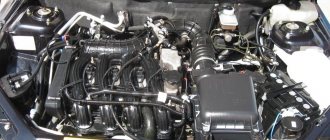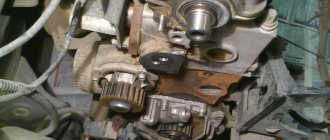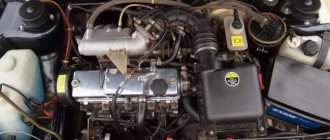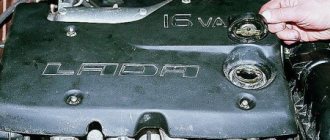The domestic automotive industry is not particularly diverse in creative thought, so most cars are technically the same as their predecessors from Soviet times. However, over the course of a long time, Russian VAZ engines have been undergoing many small changes, modifications and improvements. Therefore, today there are a number of power units that are characterized by unpretentiousness, reliability and durability.
The actual resource of the list below is neither more nor less - about 300 thousand kilometers (of course, subject to operation in accordance with the manufacturer’s requirements).
VAZ-21179
This engine was created on the basis of the 127 and received an increased piston stroke. Designed for installation in Lada Vesta, Largus and Xray.
It is equipped with both automatic (robotic) and mechanical transmission. It is the first VAZ engine to feature a phase shifter.
Characteristics
Currently it is the most powerful Lada engine.
This engine definitely has development prospects. For example, the phase regulator is currently installed on only one camshaft. In the future, in order to increase power, a phase shifter will appear on the second shaft.
| Type | Petrol |
| Compression ratio | 10,3 |
| Volume | 1.8 l |
| Cylinder diameter | 82 mm |
| Piston stroke | 84 mm |
| Cylinder arrangement | Row |
| Number of cylinders | 4 |
| Number of valves | 16 |
| Power | 122 hp |
| Torque | 170 Nm |
The engine's performance is sufficient for both everyday driving and the highway. The motor is quite reliable and meets all modern environmental standards.
Advantages
The only plus of this motor is that it is really powerful. Its performance has gone far ahead compared to its predecessor, which had 106 horsepower.
In addition, the 179th engine received a more reliable timing drive with a stronger pump.
This engine is paired with a JR5 manual transmission. This is one of the most reliable units that will not cause problems to the car owner. Unfortunately, this is where the advantages end.
Flaws
Alas, the era of cheap-to-maintain Lada engines is coming to an end. The VAZ-21179 has a number of disadvantages that the modern consumer will not like:
- replacing a timing belt is more expensive than that of foreign cars - 30 thousand rubles;
- high fuel consumption;
- some engines are prone to oil consumption;
- When the timing belt breaks, the pistons “meet” the valves.
In general, the motor is repairable and despite expensive maintenance, in all other respects it is in no way inferior to many foreign analogues.
Conclusion
Therefore, to summarize and name the best VAZ engine, we give preference to the 21127 power unit, which in all respects is ahead of its competitors in this impromptu rating, but with one amendment, since its owners should be prepared for significant financial costs in the event of unexpected malfunctions . This top of the best is our subjective opinion and you may well either support it or disagree with our opinion. You can always present your arguments on this matter with reviews in the comments on the forum, share interesting photos and videos, and also offer your own options, which, in your opinion, are worthy of the title of the best VAZ engine.
Share with your friends:
VAZ-21129
Modified continuation of the VAZ-21127 engine. Essentially, it is a modern descendant of the very old 21083 motor.
It was first installed on Sputniks in 1984. Initially it was an 8-valve engine, but in 1997 it was adapted to a 16-valve cylinder head. It was then that the VAZ 2112 received a look similar to the modern one.
And yet, it is much more powerful than its older predecessor - the 126 engine.
Specifications
The key feature is the use of lightweight CPG. This has improved traction characteristics, because now the maximum torque level has decreased to 4200 rpm (versus 5800 for the 127th).
| Type | Petrol |
| Compression ratio | 10,5 |
| Volume | 1.6 l |
| Cylinder diameter | 82 mm |
| Piston stroke | 75.6 mm |
| Cylinder arrangement | Row |
| Number of cylinders | 4 |
| Number of valves | 16 |
| Power | 106 hp |
| Torque | 148 Nm |
Compared to the VAZ-21127, this engine is better suited for the city. There is enough traction throughout the entire operating speed range. Therefore, there is no need to turn the engine from traffic light to traffic light. The changes are also felt on the track when overtaking.
What are the advantages of this engine
The advantages are that its design differs little from the old VAZ 21124 and 21126. Servicing this engine is as easy as the old units, and the price of spare parts is much more affordable than that of any foreign car.
Therefore, this engine can be called simple and repairable, which cannot but please the modern car owner, who is accustomed to doing everything with his own hands.
In addition to everything, there are other advantages:
- high availability of spare parts;
- low cost of maintenance;
- the possibility of using cheaper - 92 gasoline;
- unpretentiousness.
The last point rather relates to the quality of gasoline. As for oil, it’s clearly not possible to pour oil into this engine. Bad oil will be immediately “reported” by the loud knocking of hydraulic compensators.
Disadvantages of the 129 engine
First of all, it is worth noting that he does not have a weak appetite. But this is logical, because any increase in power leads to increased fuel consumption.
For comparison, the 1.6-liter Solaris engine, which is similar in all respects, consumes a whole liter less.
The second problem concerns engines manufactured before 2022 - damage to the valves when the timing belt breaks.
At the moment, this problem has been solved and the pistons are supplied to the conveyor with a groove.
Oil consumption
Many readers are convinced that increased oil consumption in the first thousand kilometers is nothing more than a myth. True, often such judgments are based only on personal experience, which is limited to the operation of one or, at best, several cars. Hundreds of cars, usually fresh off the assembly line, passed through the editorial office of the magazine “Behind the Wheel.” As a result, ZR experts have accumulated enormous experience in terms of operation. We have something to compare with. So, oil consumption for engines produced by VAZ, as a rule, begins to increase noticeably at 100,000 km. The reason may be oil consumption due to waste, or leaks of various engine seals. For comparison: the mileage of the editorial Lada Largus with the Renault K4M engine is already 125,000 km, and no drop in the oil level on the dipstick is observed at all.
Engine 11189
If there is something that is characterized by severe simplicity and reliability, it is the 8-valve VAZ-11189 engine. This is the youngest variation of the 21083 engine.
Key features are a modern fuel injection system with electronic throttle valve. The motor fits perfectly into modern Euro-5 toxicity standards, is quite high-torque and the cheapest.
Characteristics
You should not expect great power indicators from this engine, since its characteristics are not far from its predecessor from the 20th century.
| Type | Petrol |
| Compression ratio | 10,5 |
| Volume | 1.6 l |
| Cylinder diameter | 82 mm |
| Piston stroke | 75.6 mm |
| Cylinder arrangement | Row |
| Number of cylinders | 4 |
| Number of valves | 8 |
| Power | 87 hp |
| Torque | 140 Nm |
It is worth noting that compared to 21083 and even 11186, the engine is modified - it has a new cooling jacket, a durable timing belt with an automatic tensioner and a lightweight CPG.
Although it lacks power, the traction characteristics are more than enough for city use.
Advantages of an 8-valve engine
Despite the weak performance, it has a number of undeniable advantages:
- availability of spare parts;
- ease of maintenance and repair;
- high reliability;
- cheapness.
Car owners are happy with this engine. The main audience is pensioners who do not need unnecessary bells and whistles, and the car should be a quiet means of transportation. Taxi drivers are also delighted.
Disadvantages 11189
All the shortcomings of this motor are associated with the low quality of components. And this:
- A problematic mass air flow sensor causes the car to stall at traffic lights.
- Bad thermostat that constantly sticks.
- Pump jamming, which leads to timing belt breakage.
- Unstable engine operation at idle.
The engine requires periodic valve adjustment, which adds maintenance work. But, fortunately, this procedure is not complicated.
Run-in
Many readers are sure that the VAZ engine needs running in no more than any foreign car. And this is also one of the common misconceptions among motorists today. First, let's figure out what running in is.
Run-in is carried out for the purpose of running in the mating surfaces of parts of units, components and the machine as a whole. When mutual movement occurs between microroughnesses, contact occurs, which leads to the formation of a working surface microrelief. The result of running-in is a decrease in the magnitude of friction forces and a decrease in wear of mating parts.
Thus, it is on VAZ engines that the effect of running-in is most noticeable, while in most foreign cars, running-in does not greatly affect the characteristics of the engine and, as a result, is practically invisible to the consumer.
H4M/HR16DE
This is a more modern engine jointly produced by Renault-Nissan. This motor is used on a huge number of cars, including Lada Vesta, Xray and Largus.
The engine itself is of higher quality than Tolyatti engines.
Specifications
The main feature is the timing belt chain drive, which protects car owners from problems associated with belt breaks. And this seriously increases engine life.
| Type | Petrol |
| Compression ratio | 10,7 |
| Volume | 1.6 l |
| Cylinder diameter | 78 mm |
| Piston stroke | 83.6 mm |
| Cylinder arrangement | Row |
| Number of cylinders | 4 |
| Number of valves | 16 |
| Power | 110-116 hp |
| Torque | 150 Nm |
In terms of its performance, the engine is an average variation between the VAZ 21129 and 21179. It performs equally well in passenger cars and even in crossovers, for example, the Renault Duster.
Advantages
The motor itself shows itself only on the positive side. Despite the use of a chain, the noise level turned out to be lower than belt units from Lada.
The absence of hydraulic compensators is considered to be a rather outdated solution. But don't rush to judge. This only increased the reliability of the engine; moreover, adjustments are not made as often as on Tolyatti engines - once every 100 thousand kilometers.
The design of the motor used weak but efficient aluminum.
The fact is that it is lighter than cast iron, reduces the load on the suspension and reduces the weight of the engine. In addition, aluminum has better heat transfer and warms up faster in cold weather.
Flaws
One of the key shortcomings that car owners themselves noticed is the replacement of spark plugs. They are iridium and are expensive.
In this case, to replace the spark plugs it is necessary to remove the manifold and change the intake seals. All this does not fit with economical maintenance.
The second point is an increased appetite for butter. Owners of cars with an H4M engine will have to check the oil level more often and, if necessary, top up. Few people will like this aspect of operation.
ZMZ-409
Years of production: 2001 to present
Installed on cars: UAZ 452, UAZ Hunter, UAZ Patriot
The in-line 4-cylinder 2.7-liter 16-valve gasoline engine ZMZ-409 can, without exaggeration, be called the best engine of all that are equipped with cars produced by the Ulyanovsk Automobile Plant (UAZ). Apart from low-quality dampers and timing chain tensioners, the condition of which must be regularly monitored, this engine does not have any significant shortcomings, and its service life is about 300,000 kilometers.
In conclusion, I note that in addition to Russian-made engines, some Lada cars are also equipped with engines from foreign manufacturers, the most reliable of which are considered to be Renault K4M and Nissan HR16DE engines.
More publications on the topic:
Did you like the post? Share!
Source
Renault engines
At the moment, these engines are considered obsolete, but they were the first on Largus and have proven themselves only on the positive side. You should start with the pros and cons.
Specifications
These engines have the same base. The only difference is the cylinder head. One engine has 8 valves, and the other has 16 valves.
| K7M | K4M | |
| Type | Petrol | Petrol |
| Compression ratio | 9,5 | 9,8 |
| Volume | 1,6 | 1.6 l |
| Cylinder diameter | 79.5 mm | 79.5 mm |
| Piston stroke | 80.5 mm | 80.5 mm |
| Cylinder arrangement | Row | Row |
| Number of cylinders | 4 | 4 |
| Number of valves | 8 | 16 |
| Power | 82-90 hp | 100-115 hp |
| Torque | 124-137 Nm | 145 Nm |
As can be seen from the table, the engines have the same volume, but it is the cylinder head that determines the power and torque.
Advantages of Renault engines
It should be noted the high reliability of these engines. There are known samples that easily ran for 400-500 thousand kilometers without repair. This is why Largus owners fell in love with these engines.
We should not forget that the pedigree of these engines begins in the 80s. This was the age of simple and unpretentious power units, and the K4M and K7M inherited that feature with dignity.
Flaws
Despite the high service life of mechanical components, electronic ones still misfire. Russian gasoline mercilessly “destroys” the oxygen sensors of these engines. Other sensors are not known for their reliability either.
Old Renault engines are already obsolete and are gradually inferior to even the latest VAZ models in terms of dynamics and efficiency.
These Russian modern VAZ engines will cover 300 thousand km without capital
The domestic automotive industry is not particularly diverse in creative thought, so most cars are technically the same as their predecessors from Soviet times. However, over the course of a long time, Russian VAZ engines have been undergoing many small changes, modifications and improvements. Therefore, today there are a number of power units that are characterized by unpretentiousness, reliability and durability.
The actual resource of the list below is neither more nor less - about 300 thousand kilometers (of course, subject to operation in accordance with the manufacturer’s requirements).
Engines "Gazelle", "Sobol", "UAZ" OJSC "Ulyanovsk Motor Plant" (UMZ)
One of the oldest domestic factories focused on the production of engines, founded on September 6, 1944. From a brief excursion into history: 1941 - in connection with the evacuation of part of the capacity of the Moscow Automobile Plant named after. I.V. Stalin began the rapid establishment of new production. Engines are starting to be installed on the legendary GAZ-MM lorry and three-ton trucks - ZIS-5.
Since 1969, the motor company has repurposed itself into the type of production familiar to modern car users under the UMP brand.
At this time, it is one of the largest enterprises in the Russian engineering complex for the production of power units of various modifications for trucks, passengers and multi-purpose vehicles of the GAZ and UAZ brands.
It is also worth noting that the Ulyanovsk plant is a full production cycle enterprise: from the development of automobile gasoline and gas-gasoline engines to the production and testing of finished products.
Today, the main product of the plant is a fairly diverse line of engines, in particular gasoline and gas-gasoline engines, including LPG, running on liquefied gas, and CNG, with compressed gas fuel, for light commercial vehicles GAZelle and Sobol. The main type of product is EvoTech power units of Euro-4 and Euro-5 environmental classes.
TOP 40 most economical cars
In particular, in this article you will find: Unfortunately, only diesel models are included in the TOP 10 of the overall rating. So if you are looking for a petrol car, go straight to the cheapest petrol cars TOP 20. Renault and Peugeot were the cheapest cars.
Of the Japanese brands, only Toyota arrived. Even the “small” Nissan Micra turned out to be too voracious: it “eats” 6.5 liters per 100 km in the combined cycle.
Rating of the most economical LADA cars (gasoline consumption)
The editors of the automobile magazine "Daily Motor" analyzed the technical characteristics of modern LADA models.
Based on this data, an assessment was compiled showing which LADA cars are the cheapest (the least fuel efficient).
Remember that the cost of servicing a car consists not only of the cost of gasoline, but also of the cost of servicing. Previously, we calculated how much one kilometer would cost for the owner of a Lada car (the calculation includes: gasoline, regular maintenance and a set of tires).
